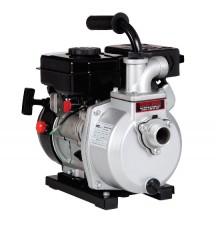-
Red Lion 617031 Model 2RLAG-1L Transfer Pump Buyers Guide & Review
June 12, 2017Welcome to another edition of Inspector Pumphead’s recommendations! In this column, I will use my skills and experience as an Inspector to highlight and explain the features and benefits of specific pump models. The pump featured here might be a best-seller, be seasonally appropriate or have unique features that set it apart from other pumps of a similar type. In today’s edition of “The Inspector Recommends,” I will be examining an engine driven water transfer pump from Red Lion pumps, the 617031 model 2RLAG-1L. Red Lion is one of our newest manufacturing partners and I am excited to feature one of its pumps for the first time on the blog! They also carry many other drive engine driven pumps. Engine or Electric The vast majority of the pumps we feature, whether automatic or manual, operate with a motor powered by an electrical outlet (or a battery if it’s a backup). Other types include hand pumps and water-powered pumps. But today, I am talking specifically about pumps powered by gasoline engines. Engine driven pumps are designed to be used in outdoor settings with no access to an electrical outlet (or generator for that matter). Typically, engine drive pumps are used in construction, drilling, mining, excavation and other outdoor job sites. It is common for liquid transfer to be an important aspect of any number of outdoor jobs. Engine driven pumps can also feasibly be used for more general water transfer applications where electricity is not available. Red Lion 617031 2RLAG-1L The Pump Itself The Red Lion 617031 2RLAG-1L pump casing is made of durable aluminum, which is lighter than the cast iron or stainless steel. The internal volute is cast iron. The pump is horizontally configured and both the suction inlet and discharge port are front-facing 1-½” MNPT. Two screw-on 1” adapters are included for the inlet and discharge; other adapter sizes can easily fit as well. A check valve to prevent backflow is built into the pump behind the suction inlet. A priming port on the top side of the pump allows for easy priming until full. A drain plug near the base allows excess water to easily be evacuated after operation. An attached base plate provides a sturdy and stable foundation of the pump, while a carry handle allows for portability around a job site. The pump should also never be run dry because water is required to lubricate the pump seal which is made of a carbon/ceramic composite. The impeller is rugged cast iron to prevent corrosion and semi-open to prevent clogging. Performance wise, the 617031 2RLAG-1L can reach a maximum capacity of 60 GPM and a maximum head of 79 ft. TDH. The maximum suction lift is 25 ft. All in all, it is a pump designed to convenience the contractor or anyone working on an outdoor site. The Engine and Operating Procedures The mounted engine is an air-cooled, 4 something 79cc OHV (overhead valve) gasoline engine. Built to meet EPA standards for efficiency, the engine runs best on unleaded gasoline and includes all the components necessary for smooth running. 1. On/off switch enables the spark ignition system to operate. In an emergency situation, the pump can be shut down by flipping the switch. 2. Fuel valve closes the passage between the fuel tank and carburetor and prevents the fuel from flooding the engine. 3. The choke adjust the levels of air and gasoline in the fuel mixture. When the choke is on, it enriches the mixture, allowing you to run the engine “cold.” 4. Throttle: Acts like the accelerator in your car and allows you to adjust the RPM to your preferred standards. 5. The recoil starter grip operates the recoil starter; pull to engage the crankshaft and start the engine. 6. A muffler to reduce noise emissions. 7. A convenient dipstick to measure the level of oil. Always be sure to check the level of oil (on a level surface) before operation to reduce the chances of damage or engine shutdown. SAE 10W-30 is recommended. 8. An air filter to filter the air. Keep in mind that the pump engine operates like any other type of engine. It is loud, requires oil for smooth operation and the exhaust fumes release carbon monoxide into the air. That is why proper operational parameters are extremely important for your health and safety when operating the engine. This pump (and any engine-driven pump) should never be operated indoors or an enclosed space. Users should also be cognizant of carbon monoxide leaking into enclosed areas. In addition to producing carbon monoxide, engine exhaust also generates intense heat. Be aware that the muffler gets extremely hot during operation and should not be touched. It is also highly recommended that you wear a pair of earmuffs or other protective ear gear during operation - you wouldn’t want to damage your eardrums! You should also wait for the engine to cool down before refueling, transporting or storing the pump. While it may some like there are a lot of precautions, read your manuals, use common sense and you should be fine. Use and Installation In the image below you can see a typical installation configuration. Pump Products application engineers are standing by to help you find the right pump, as well as to provide price quotes, availability and shipping information. Call our toll free number 1-800-429-0800.






